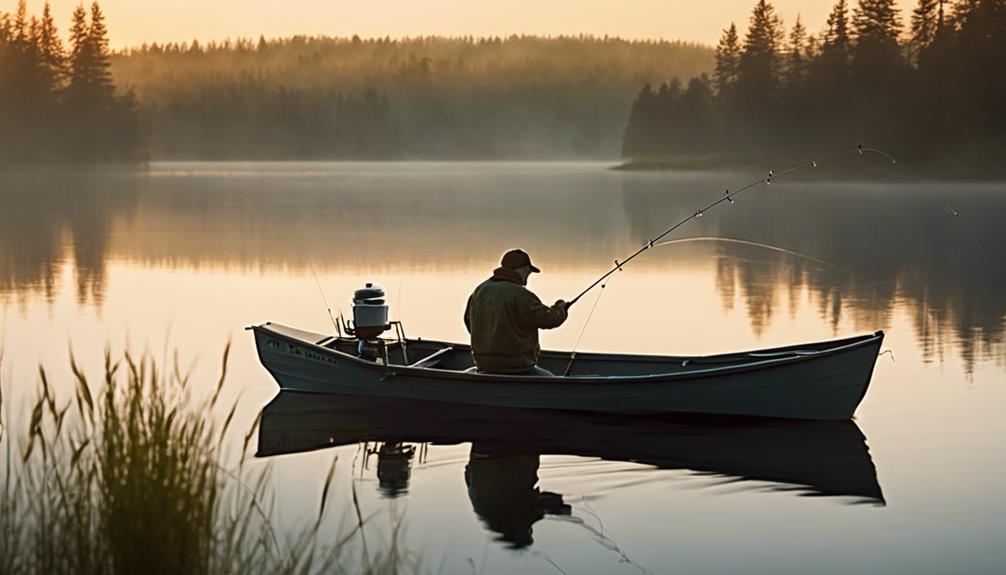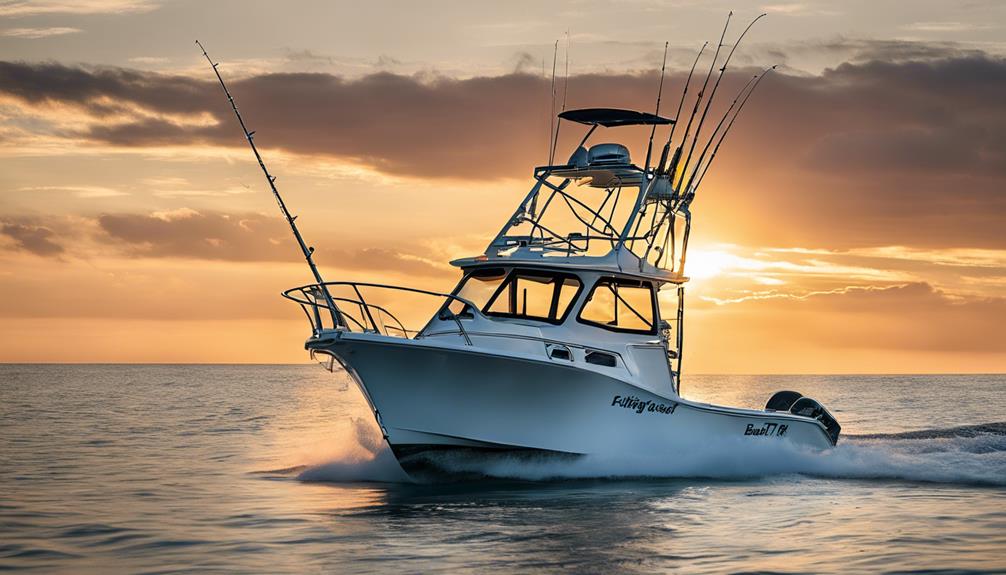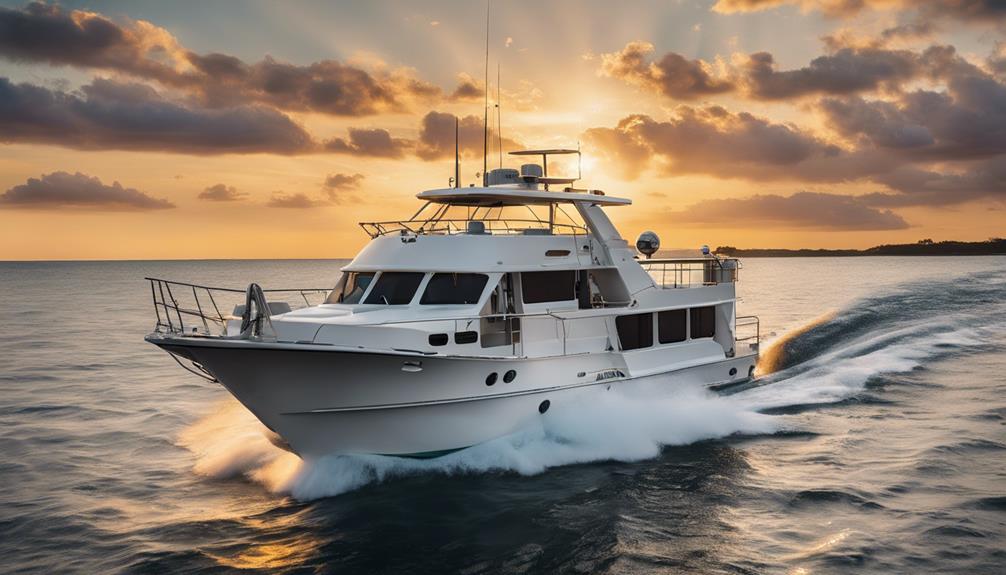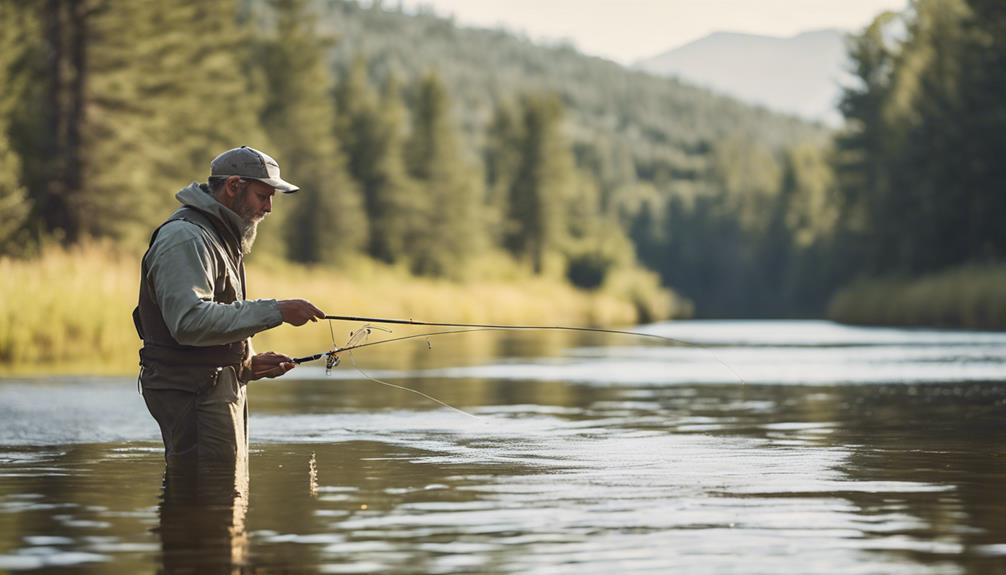Master successful walleye angling by following these six essential tips. Focus on spring and fall seasons when walleye are active and shallow. Experiment with live bait like minnows and artificial lures such as crankbaits. Seek walleye near structures in well-oxygenated waters. Equip yourself with quality gear like a sensitive rod with fast action. Understand walleye feeding habits during low-light conditions. Prioritize safety with a PFD, weather checks, and emergency communication. Improve your chances by applying these tips and enhancing your walleye angling skills.
Best Time to Fish Walleye
When targeting walleye, it's crucial to time your fishing efforts strategically to increase your chances of success. Understanding the prime season for walleye fishing is essential. In most regions, the best time to target walleye is during the spring and fall. During these seasons, walleye are more active and tend to be shallower, making them easier to locate and catch.
Weather conditions play a significant role in walleye behavior. Walleye are known to be sensitive to changes in barometric pressure. A falling barometer, often associated with incoming storms, can trigger increased walleye activity as they sense a feeding opportunity before the weather worsens. Therefore, fishing ahead of a front can be particularly productive. Additionally, overcast days or low-light conditions such as dawn and dusk are prime times to target walleye as they're naturally more active during these periods.
In terms of seasons, the spring spawn is a highly anticipated time for walleye anglers. As water temperatures rise, walleye move into shallower waters to spawn, making them more accessible to anglers. Fall is another prime season as walleye feed heavily to fatten up for the winter months. Understanding these seasonal patterns and how weather influences walleye behavior can greatly increase your chances of a successful fishing trip.
Choosing the Right Bait
Choosing the right bait plays a crucial role in enticing walleye to bite and increasing your chances of a successful fishing outing. When targeting walleye, you have two main options: live bait or artificial lures. Live bait such as minnows, leeches, and nightcrawlers can be highly effective, especially when presented naturally and in a lively manner. Walleye are known to be quite responsive to live bait due to their natural predatory instincts. Ensure your live bait is fresh and lively to maximize its attractiveness to walleye.
On the other hand, artificial lures can also be productive when targeting walleye. Crankbaits, jigs, and spinners are popular choices among anglers. When selecting artificial lures, consider factors such as water clarity, depth, and time of day. For example, brightly colored lures may work well in murky waters, while more natural hues can be effective in clear conditions. Additionally, the depth at which walleye are feeding should influence your choice of lures – diving crankbaits can be ideal for reaching deeper fish.
Experimenting with different types of bait and observing how walleye respond can help you determine the most effective option for your fishing situation. Remember to adapt your bait choice based on the conditions and the behavior of the fish to optimize your chances of landing a prized walleye.
Mastering Walleye Fishing Techniques
To excel in walleye fishing, honing your skills in mastering various techniques is key to consistently reeling in these elusive and prized fish. When it comes to catching techniques, varying your approach can make a significant difference in your success rate. Experiment with different jigging speeds, depths, and movements to see what triggers the walleye to strike. Additionally, maintaining your equipment is crucial for optimal performance. Regularly check and sharpen your hooks, replace any worn-out lines, and ensure your reels are properly lubricated to prevent malfunctions during crucial moments.
Incorporating effective fishing strategies is essential for a successful walleye angling experience. Pay attention to weather patterns, as walleye are known to be more active during overcast days or low-light conditions. Adjust your techniques accordingly, such as using brighter lures on cloudy days to increase visibility. Understanding the behavior of walleye in different weather conditions can significantly improve your chances of a good catch.
Locating Walleye Hotspots
Discovering walleye hotspots requires a keen understanding of their preferred habitat and feeding behaviors. When it comes to locating these elusive fish, paying attention to specific environmental factors is key. Here are some essential tips to help you pinpoint walleye hotspots:
- Water Temperature: Walleye are known to be sensitive to water temperature. They often prefer cooler waters ranging between 55°F to 68°F. During the warmer months, look for areas with temperature variances or thermoclines where walleye may seek relief from higher temperatures.
- Depth Variations: Walleye are versatile predators that can be found at various depths depending on the time of day and season. They tend to move to shallower waters during low-light conditions to feed. However, during the day, they may retreat to deeper areas. Understanding these depth variations can significantly increase your chances of locating walleye hotspots.
- Underwater Structures: Walleye are ambush predators that like to hide around underwater structures such as rock piles, submerged trees, and drop-offs. These structures provide cover for walleye to wait for their prey. Pay close attention to these areas when scouting for walleye hotspots.
- Currents and Oxygen Levels: Walleye are often found in areas with moderate currents that help disperse their prey. Additionally, they prefer well-oxygenated waters. Look for areas where currents bring in fresh oxygen, such as inflows or areas near aerators.
- Forage Availability: Walleye are opportunistic feeders and will often be found near their prey. Understanding the local forage base, whether it's baitfish or insects, can guide you to potential walleye hotspots.
Understanding Walleye Behavior
When targeting walleye, understanding their behavioral patterns is fundamental to increasing your angling success. Walleye are known for their feeding habits, which often involve hunting for prey during low light conditions such as dawn, dusk, and nighttime. They've excellent low-light vision due to a reflective layer behind their retinas called the tapetum lucidum, allowing them to see well in darker waters. This makes early morning and evening prime times for angling walleye. When it comes to feeding, walleye prefer smaller fish like minnows, shad, and perch, but they also consume insects, crayfish, and worms. Using lures that mimic these prey items can be highly effective in enticing walleye to bite.
Another crucial aspect of understanding walleye behavior is their spawning behavior. Walleye typically spawn in the early spring when water temperatures reach around 42-50°F. They migrate to shallow rocky or gravelly areas to spawn, with females releasing their eggs while males fertilize them externally. After spawning, walleye may exhibit post-spawn lethargy and feed more actively to regain lost energy. Understanding these behaviors can help anglers target walleye more effectively during different seasons.
Essential Gear for Walleye Angling
What equipment is essential for successful walleye angling expeditions? When gearing up for walleye fishing, having the right tools is crucial to maximize your chances of a successful catch. Here are some key gear essentials to consider:
- Quality Fishing Reel: A smooth, reliable fishing reel is essential for handling the fight of a walleye. Look for a reel with a smooth drag system and a gear ratio suitable for walleye angling.
- Sensitive Rod: Opt for a medium to medium-light rod with a sensitive tip to feel the subtle bites of walleye. A rod with a fast action will help with hook sets and playing the fish effectively.
- Variety of Lures: Walleye can be picky, so having a selection of lures like jigs, crankbaits, and spinners in different colors and sizes can help you adapt to changing conditions.
- Quality Fishing Line: Use a high-quality monofilament or fluorocarbon line with good strength and low visibility to increase your chances of landing walleye.
- Tackle Box with Essentials: Ensure your tackle box is stocked with essentials like extra hooks, sinkers, swivels, and leader material for quick adjustments on the water.
Tips for Catching Trophy Walleye
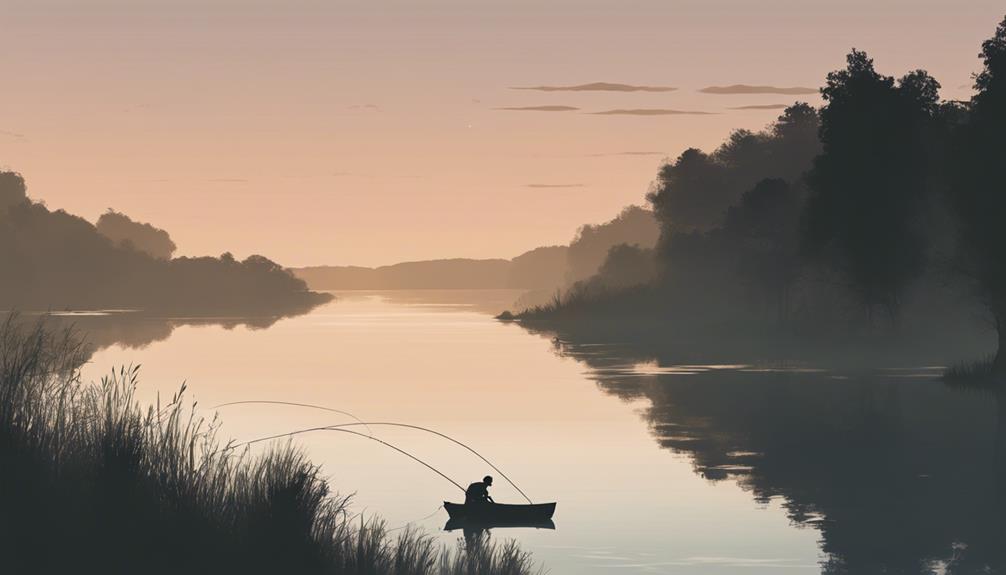
To increase your chances of landing a trophy walleye, mastering the art of precision casting is crucial. Trophy walleye are often found in specific habitats that offer them protection and access to their prey. Look for structures such as rocky points, deep weed beds, submerged islands, and drop-offs near spawning areas. These locations provide ideal hunting grounds for trophy walleye.
Understanding weather patterns is also essential for successful trophy walleye fishing. Walleye are known to be more active during low-light conditions such as dawn, dusk, and cloudy days. Pay attention to wind direction and speed, as walleye tend to gather on the windy side of a water body where baitfish are pushed by the current. Additionally, changes in barometric pressure can impact the feeding behavior of walleye. A falling barometer often triggers increased feeding activity, making it a prime time to target trophy walleye.
When targeting trophy walleye, consider using larger baits and lures to attract these bigger, more experienced fish. Experiment with different colors, sizes, and types of lures to see what works best in the specific habitat you're fishing. By combining precision casting with knowledge of trophy walleye habitats and weather patterns, you can significantly increase your chances of landing that prized catch.
Safety Precautions on the Water
Ensuring your safety on the water is paramount when engaging in walleye angling. Walleye fishing can be an exciting adventure, but being prepared for any unexpected situation is crucial. Here are some essential safety precautions to consider for a safe and enjoyable angling experience:
- Wear a Personal Flotation Device (PFD): Always wear a Coast Guard-approved PFD while on the water. In case of an emergency, a PFD can be a lifesaver, especially in rough waters or if you fall overboard.
- Check the Weather Forecast: Before heading out, make sure to check the weather forecast. Sudden storms or high winds can pose significant risks on the water. It's essential to be aware of any potential weather changes to stay safe.
- Emergency Communication: Carry a reliable means of communication, such as a fully charged cell phone or a VHF radio. In case of an emergency, being able to call for help can make a critical difference.
- Boat Maintenance: Regularly maintain your boat and check all safety equipment, including navigation lights, bilge pumps, and engine. Proper maintenance can prevent breakdowns and ensure a safe trip.
- Inform Someone of Your Plans: Before heading out, let someone know your angling plans, including your location and expected return time. In case you encounter difficulties, having someone aware of your whereabouts can aid in quicker rescue operations.
Frequently Asked Questions
How Do Weather Conditions Affect Walleye Fishing Success?
When weather conditions shift, walleye fishing success can vary. Temperature fluctuations impact walleye behavior, affecting their feeding patterns. Pressure changes can also influence their activity levels.
Wind speed can stir up the water, making it harder to locate walleye. Precipitation patterns can alter water clarity, affecting visibility.
Understanding how these factors interact with each other and with the walleye's habits can help you adapt your strategy for more successful angling trips.
What Are Common Mistakes to Avoid When Targeting Walleye?
When targeting walleye, it's important to focus on several key areas to increase your chances of success:
- Equipment selection: Ensure your gear is suited for the conditions, including the right rods, reels, lines, and lures for walleye fishing.
- Techniques refinement: Learn and practice different fishing techniques, such as jigging, trolling, or casting, to adapt to various situations on the water.
- Bait presentation: Pay attention to how you present your bait, including the depth, speed, and movement to entice walleye to strike.
- Location scouting: Spend time scouting for productive fishing spots, such as weed edges, drop-offs, or structure where walleye are likely to be feeding.
Can Underwater Structures Impact Walleye Behavior?
Underwater structures like rock piles, reefs, and weed beds can significantly impact walleye behavior. These habitats serve as shelters, feeding grounds, and breeding areas for walleye. Understanding how these structures influence walleye movement and habits is crucial for successful angling.
Walleye exhibit specific behavioral patterns around these habitats, such as seeking cover in rocky areas or ambushing prey near vegetation. By recognizing and adapting to these behaviors, anglers can increase their chances of catching walleye.
Are There Specific Colors That Attract Walleye Better?
When choosing lures for walleye fishing, consider the water clarity.
In clear water, opt for natural colors like silver, white, or chartreuse to mimic baitfish.
In murky water, go for brighter hues like orange, red, or pink to increase visibility.
Experiment with different shades based on the conditions to attract more walleye.
How Can I Prevent Losing Walleye When Reeling Them In?
When reeling in walleye, ensure a solid hook setting by lifting your rod tip sharply to drive the hook into the fish's mouth.
Maintain proper tension on the line to prevent the walleye from shaking off the hook.
Be vigilant with your line management, keeping it tight to control the fish's movements.
Conclusion
Now that you have mastered these essential tips for successful walleye angling, you're ready to hit the water with confidence. Remember to consider the best time to fish, choose the right bait, and master key techniques.
Locate walleye hotspots, understand their behavior, and ensure you have the right gear.
With these tips in mind, you'll be well on your way to catching trophy walleye and staying safe on the water.
Happy fishing!
